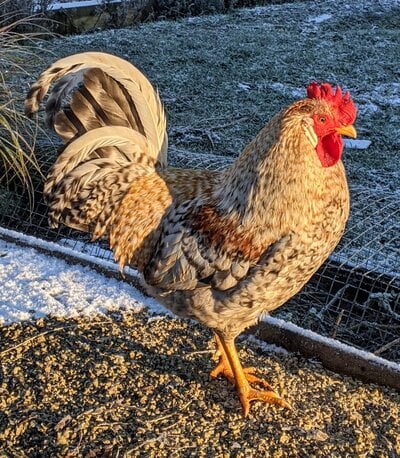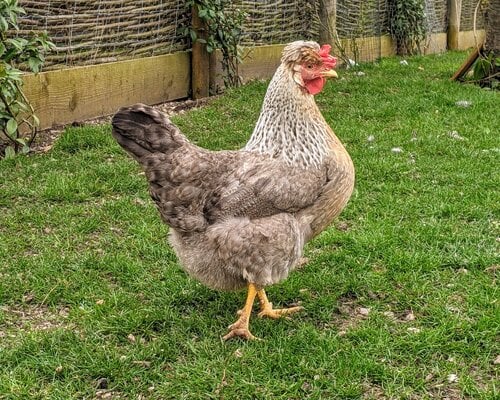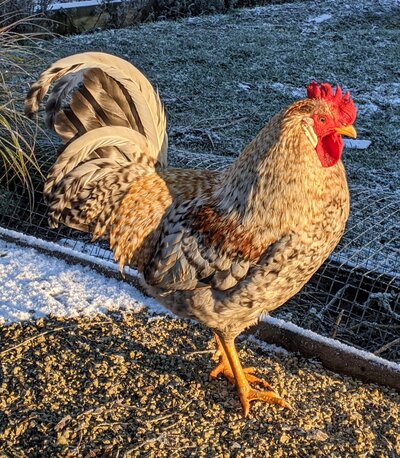connieconnie
Songster
So I've recently been sucked into the black hole of what is chicken colouring genetics. And after days of research... I'm still a bit confused 
I've discovered how wonderfully complex and interesting this area is! And would like some advice, thoughts, opinions or maybe some links to information.
I have a small backyard flock here in the UK, with a Cream Legbar cockerel (CL) and a collection of unrelated hens of different breeds (Blue copper Maran (M), Black copper Maran (M), Silver Grey Dorking (SGD), Barred Plymouth Rock (BPR) and Crested Cream Legbar (CL)). On March 30th 2021 (a couple of days ago), I hatched 3 Purebred Cream Legbars (CLxCL), 3 Copper Maran cross Cream Legbars (MxCL) and 2 Barred Plymouth Rock cross Cream Legbars (BPRxCL)

I was surprised to get a yellow chick with feathered legs and a chick with no feathered legs from my MxCL!
I was wondering:
Cream Legbar Cockerel crossed with Cream Legbar Hen (CLxCL):













Cream Legbar Cockerel crossed with either Blue or Black copper Maran Hen (CLxM):














Cream Legbar Cockerel crossed with Barred Plymouth Rock Hen (CLxBPR):










(my other two chicks, just if you are interested - not CL cross) Purebred Maran chicks (MxM):










Please let me know if from these chicks you can decipher their sex or genetics, including if you can work out any indices of the genetics of the parents (Cockerel or Hens). Thank you so much for your help!
I was wondering if because I got a yellow, non-barred chick from CLxM, then my Cockerel (Noodle) only has one Barring gene? As this chick has no barring, is it more likely to be male?
will post photos of the parents

I've discovered how wonderfully complex and interesting this area is! And would like some advice, thoughts, opinions or maybe some links to information.
I have a small backyard flock here in the UK, with a Cream Legbar cockerel (CL) and a collection of unrelated hens of different breeds (Blue copper Maran (M), Black copper Maran (M), Silver Grey Dorking (SGD), Barred Plymouth Rock (BPR) and Crested Cream Legbar (CL)). On March 30th 2021 (a couple of days ago), I hatched 3 Purebred Cream Legbars (CLxCL), 3 Copper Maran cross Cream Legbars (MxCL) and 2 Barred Plymouth Rock cross Cream Legbars (BPRxCL)


I was surprised to get a yellow chick with feathered legs and a chick with no feathered legs from my MxCL!
I was wondering:
- what these chicks feather colouring will be in the future?
- if there is any sex identification that can be done from hatch?
- and why a Maran cross chick can not have feathered legs?
Cream Legbar Cockerel crossed with Cream Legbar Hen (CLxCL):
- Chick 1 (Honey) CLxCL - Yellow, chipmunk pattern, yellow legs, no yellow headspot - female?
- Chick 2 (Popcorn) CLxCL - Yellow, Yellow legs, white headspot, fleck of brown on forehead, very light gingery chipmunk pattern - male?
- Chick 3 (Butter) CLxCL - Yellow, Yellow legs, white scattered headspot, very light gingery chipmunk pattern - male?
Cream Legbar Cockerel crossed with either Blue or Black copper Maran Hen (CLxM):
- Chick 4 (Pita) CLxM - Yellow, Yellow feathered legs, light yellow underbelly with slightly more gingery top, no headspot
- Chick 5 (Momo) CLxM - Black, white chest, Large white headspot, feathered legs, Yellow legs
- Chick 6 (Katsu) CLxM - Black, white chest, scattered white headspot with some ginger marks within, no feathering on legs
Cream Legbar Cockerel crossed with Barred Plymouth Rock Hen (CLxBPR):
- Chick 7 (Tamari) CLxBPR - Black, black chest, scattered white headspot, white mark on under left eyelid
- Chick 8 (Seaseme) CLxBPR - Black, Black chest, smallest chick, defined white headspot in 'J' shape
(my other two chicks, just if you are interested - not CL cross) Purebred Maran chicks (MxM):
- Chick 9 (Bamboo) MxM - Light grey, white chest and white markings
- Chick 10 (Ginger) MxM - Dark grey, white chest and white markings
Please let me know if from these chicks you can decipher their sex or genetics, including if you can work out any indices of the genetics of the parents (Cockerel or Hens). Thank you so much for your help!
I was wondering if because I got a yellow, non-barred chick from CLxM, then my Cockerel (Noodle) only has one Barring gene? As this chick has no barring, is it more likely to be male?
will post photos of the parents






